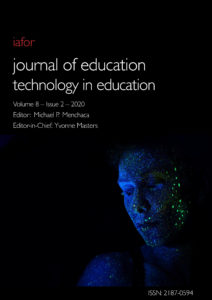IAFOR Journal of Education: Volume 8 – Issue 2 – Technology in Education
Editor: Michael P. Menchaca
Editor-in-Chief: Yvonne Masters
Published: July 17, 2020
ISSN: 2187-0594
https://doi.org/10.22492/ije.8.2
Welcome to the IAFOR Journal of Education’s inaugural Technology in Education issue. While the Journal structure may be slightly altered at times, our commitment to interdisciplinary, international, intercultural, quality manuscripts remains. As editor, I rely heavily on an extensive group including the editor-in-chief, two associate editors, and an incredible team of reviewers. I am truly humbled by everyone’s dedication, hard work, and support, especially given the challenges brought on by the global pandemic. Given current circumstances, technology becomes even more significant in facilitating collaboration in the world. Although IAFOR has reserved a special topic issue for manuscripts specifically related to the impact of COVID-19, technology, particularly in education, plays an important role in our collective progress.
 The scope of Technology in Education is purposefully broad to ensure the greatest representation of contemporary knowledge impacting all learning, formal and informal. The journal’s simple aim to improve education requires broad representation in scope and extensive comprehension in depth. To achieve such depth, one factor binds all published manuscripts, firm theoretical foundations. As editor, my one piece of advice to prospective authors: connect your study to sound theoretical or conceptual foundations.
The scope of Technology in Education is purposefully broad to ensure the greatest representation of contemporary knowledge impacting all learning, formal and informal. The journal’s simple aim to improve education requires broad representation in scope and extensive comprehension in depth. To achieve such depth, one factor binds all published manuscripts, firm theoretical foundations. As editor, my one piece of advice to prospective authors: connect your study to sound theoretical or conceptual foundations.
Reflecting IAFOR’s commitment to diverse knowledge and international collaboration, the nine published studies encompass:
- Five continents: Asia, Europe, Africa, North America, and Oceania;
- Seven countries: Malaysia, the Philippines, Turkey, Rwanda, the United States, Mexico, and Papua New Guinea;
- Three studies focusing on open education: MOOCs; Open Educational Resources; and Open Textbooks;
- Three studies focusing on online learning: learning management systems; online journalism; and a virtual language exchange;
- Three studies focusing on general e-learning: informal language learning through digital media; digital annotations; and digital literacy.
I hope you enjoy reading these articles as much as I enjoyed reviewing them.
Michael P. Menchaca
tech.editor.joe@iafor.org
Editor, IAFOR Journal of Education: Technology in Education

